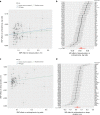Genome-wide association study identifies genetic loci for self-reported habitual sleep duration supported by accelerometer-derived estimates
- PMID: 30846698
- PMCID: PMC6405943
- DOI: 10.1038/s41467-019-08917-4
Genome-wide association study identifies genetic loci for self-reported habitual sleep duration supported by accelerometer-derived estimates
Abstract
Sleep is an essential state of decreased activity and alertness but molecular factors regulating sleep duration remain unknown. Through genome-wide association analysis in 446,118 adults of European ancestry from the UK Biobank, we identify 78 loci for self-reported habitual sleep duration (p < 5 × 10-8; 43 loci at p < 6 × 10-9). Replication is observed for PAX8, VRK2, and FBXL12/UBL5/PIN1 loci in the CHARGE study (n = 47,180; p < 6.3 × 10-4), and 55 signals show sign-concordant effects. The 78 loci further associate with accelerometer-derived sleep duration, daytime inactivity, sleep efficiency and number of sleep bouts in secondary analysis (n = 85,499). Loci are enriched for pathways including striatum and subpallium development, mechanosensory response, dopamine binding, synaptic neurotransmission and plasticity, among others. Genetic correlation indicates shared links with anthropometric, cognitive, metabolic, and psychiatric traits and two-sample Mendelian randomization highlights a bidirectional causal link with schizophrenia. This work provides insights into the genetic basis for inter-individual variation in sleep duration implicating multiple biological pathways.
Conflict of interest statement
F.A.J.L.S. has received speaker fees from Bayer Healthcare, Sentara Healthcare, Philips, Kellogg Company, and Vanda Pharmaceuticals. M.K.R. reports receiving research funding from Novo Nordisk, consultancy fees from Novo Nordisk and Roche Diabetes Care, and modest owning of shares in GlaxoSmithKline. The remaining authors declare no competing interests.
Figures




References
Publication types
MeSH terms
Grants and funding
- MR/P023576/2/MRC_/Medical Research Council/United Kingdom
- MC_UU_00011/2/MRC_/Medical Research Council/United Kingdom
- R03 MH108908/MH/NIMH NIH HHS/United States
- MR/P012167/1/MRC_/Medical Research Council/United Kingdom
- R01 HL113338/HL/NHLBI NIH HHS/United States
- T32 HL007901/HL/NHLBI NIH HHS/United States
- R35 HL135818/HL/NHLBI NIH HHS/United States
- 107851/Z/15/Z/WT_/Wellcome Trust/United Kingdom
- U01 HL053941/HL/NHLBI NIH HHS/United States
- F32 DK102323/DK/NIDDK NIH HHS/United States
- MR/M005070/1/MRC_/Medical Research Council/United Kingdom
- K01 HL136884/HL/NHLBI NIH HHS/United States
- R01 DK107859/DK/NIDDK NIH HHS/United States
- R01 DK102696/DK/NIDDK NIH HHS/United States
- MC_UU_00011/6/MRC_/Medical Research Council/United Kingdom
- K01 HL135405/HL/NHLBI NIH HHS/United States
- R01 DK105072/DK/NIDDK NIH HHS/United States
LinkOut - more resources
Full Text Sources
Other Literature Sources
Miscellaneous

